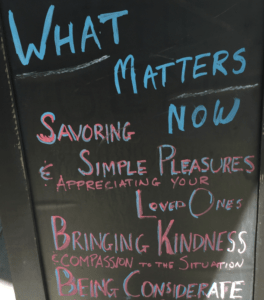 Resist the temptation to throw your hands up in the air because you’re hearing people are giving less now. While it may be true(ish), it doesn’t apply to everyone. And it doesn’t need to apply to your nonprofit.
Resist the temptation to throw your hands up in the air because you’re hearing people are giving less now. While it may be true(ish), it doesn’t apply to everyone. And it doesn’t need to apply to your nonprofit.
Also, the fact folks aren’t giving may not be for the reasons you assume. In fact, one of the biggest reasons this is true is because nonprofits are asking less.
If you don’t ask, you don’t get.
Recent research shows:
- Giving is increasingly seen as good – as is fundraising. Even donors who have been hit economically are remaining remarkably generous.
- Charities with little relevance to tackling Coronavirus will still receive support from donors that value them – as long as they ask for help (otherwise they’ll be perceived as not in need of funds).
It all boils down to a need to put together both short and long-term plans to connect meaningfully with your supporters right now, using the correct approach and tone. Towards that end, I’ve put together five ‘to-do’s – one for each day of the work week. I suggest you put aside a little bit of time this coming week to consider how you might actualize each of these suggestions, if not in whole at least in part.
Ready for your five timely tips?
TIP #1: 4-Step Message Formula for this Uncertain Time
 Whether it’s a marketing or fundraising communication, keep these four basics in mind.
Whether it’s a marketing or fundraising communication, keep these four basics in mind.
- Clarity and confidence. Get clarity on your reason (WHY) for sending this particular message; then assure your message is a confident expression (WHAT) of your rationale. Make these two characteristics part of every message you create. And don’t muddy the waters. Each message has a singular overarching goal. If may be information… a solution to a problem… or even a welcome escape for your constitutents. Highlight what it is, and why it matters, in all your communication channels.
- Steadiness. Although this crisis isn’t going away soon, neither are you. Steady, calm, and measured language will help constituents understand you’re there for them — now and in the future. This does not mean gas lighting folks or ignoring the elephant in the room. If you steadily obfuscate, or offer platitudes, you’re not offering clarity. Nor are you getting across the message your stability depends upon. Which is you and your community coming together.
- Urgency. There’s a lot of fundraising noise; you must cut through it. While keeping calm, highlight the urgency of a donation in clear terms. What will a gift accomplish? What will happen if you don’t meet your goal? Help the donor visualize precisely how their gift will make an impact. And, of course, have a plan in place to report back to donors who respond to your call to action so they can trust their gifts were put to work as intended.
- Normalcy. As you create and promote content, keep in mind many people are looking for temporary escape. You do need to acknowledge the crisis to be credible, yet not everything you say needs to be about it. Find something about what you do that feels like what you’ve always done, more or less. Continue to showcase the parts of your mission people have always cared about and supported, even though some of the ways you’re implementing programs and services may be evolving.
TIP #2: Be the Bearer of Good News
 Donors don’t want to go down with a sinking ship.
Donors don’t want to go down with a sinking ship.
Share any good news you have to offer. It may be you got a PPP loan to tide you over. Or it may be you have a new plan to pivot programs to a different format. Good news will offer donors hope, and make them feel better about your prospects for survival. This will make them more likely to stay on board.
If you don’t have good news, find some. I recently received a fundraising email from the Fine Arts Museums of San Francisco. At the bottom, I was pleased to see them include information informing supporters about new tax deduction benefits made possible through the CARES Act. What donors don’t know, they won’t take advantage of – and that will be to everyone’s detriment.
 I wrote about these new giving incentives here. You can also grab all the details in the “Read Additional Guidelines” link which goes to the AFP website.
I wrote about these new giving incentives here. You can also grab all the details in the “Read Additional Guidelines” link which goes to the AFP website.
IMPORTANT NOTE: I always recommend you let donors know you are not in the business of offering professional legal or financial advice, and they should consult with their own advisors.
TIP #3: Use this Time to Conduct a Brief Donor Survey
 Donor surveys offer you a “twofer.”
Donor surveys offer you a “twofer.”
- One is for you(useful information).
- One is for your donor(a way to usefully participate other than giving money).
People want to be helpful right now, so they just may participate in larger numbers than would have been true in the past. It’s a way to connect without asking for money (you always want a balance of communication strategies), and this makes sure you don’t fall ‘out of sight’ (which can become ‘out of mind’ all too quickly). This information can be gold to you as you prepare your content calendar and campaign materials moving forward. [See 2 Reasons Donor Surveys are Valuable].
Surveys facilitate your transition from “organization-centric” to “donor-centric” communications. After surveying your supporters you’ll know what your donors want you to tell them (vs. what you want to tell them). This is a huge deal! In fact, it’s been documented in recent research related to Coronavirus messaging from Blue Frog Fundraising. Penelope Burk nailed this when she said, years ago, in her ground-breaking “Donor-Centered Fundraising” book: “Show me that you know me.”
TIP #4: Take Major Donor Research off the Back Burner
 Don’t rely on guesses and hunches. Work smart!
Don’t rely on guesses and hunches. Work smart!
There’s no more cost-effective fundraising strategy than major gifts development. But you need the right prospects for your organization. This requires methodical research.
Sadly, many nonprofits have this project way at the bottom of their ‘to-do’ list. Right now you may have time to move this to the top of your list, where it always should have been.
You don’t necessarily need to purchase research or append predictive models to your database. This isn’t a bad idea, but I don’t want you to use the fact you don’t have the resources for this right now as an excuse to whiff on the entire project. Because when you have major donors they’ll often account for 70 – 90% or more of all your contribution income! You can learn a tremendous amount just by doing internet searches on prospects. Plus you can query your board members and other major donors to find out what they know about some of your top prospects.
If you don’t look for major donors, you won’t find them. They aren’t delivered by the stork!
TIP #5: Time to Do Spring Database Clean-up!
 Prepare your list for your upcoming fall campaign.
Prepare your list for your upcoming fall campaign.
Did you know 10% of all U.S. nonprofit mail appeals won’t even be delivered?
That’s because nearly 45 million Americans move each year, and for many their mail is undeliverable because of incorrect addresses. Yipes!
Use services such as the National Change of Address (NCOA) at least once a year to keep up with current home addresses. This can save you a significant amount money as addresses change frequently due to moves, divorces and deaths. There’s a new tool called TrueNCOA that will process any file for $20 using the NCOA records of the US Postal Service. They’ll also do address verification and eliminate duplicates — all for the single fee.
SUMMARY: Tip-a-Day-DO-Dah!
Monday
Review your next planned message and reframe using the 4-step message formula outlined above:
(1) Clarity; (2) Steadiness; (3) Urgency and (4) Normalcy.
If you don’t have a message cued up, plan to send one. Don’t go dark on folks now. Please trust me on this one. Out of sight is out of mind.
Tuesday
Consider what good news you might share. Also consider adding information about CARES Act tax benefits to your donation landing page.
Wednesday
Plan a donor survey. It can be very simple, with just a few questions, using a free service like Survey Monkey or Google Docs.
Thursday
Review your major donor prospects. You may have already been approaching existing major donors to ask for larger gifts. It’s time to dig deeper into your database and look at mid-level donors who may have both the capacity and inclination to give more.
Friday
Clean up your mailing lists! Your appeal is only as good as who it is sent to. Take off duplicates and bad addresses. Make sure your salutation fields are filled in appropriately (today, informal is better). Purge your lists of folks who haven’t responded to you in five years or more.
Week-End
Rest! You’ve earned it.
Photos are mine from recent walks around San Francisco neighborhoods. And, yes, that masked marauder c’est moi.





